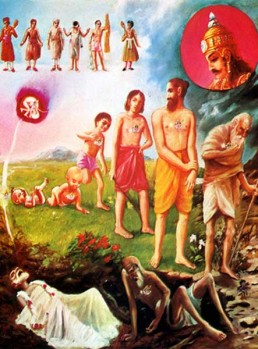Swami Chinmayananda Commentary
It is amply clear that if a thing cannot be annihilated by any of the known methods of destruction of nature, or those invented and perfected by man, then that given object must be everlasting.
Here, in the second line, we have a series of qualities listed, indicating the Truth; they are not a haphazard collection of terms picked up at random and used in haste. Each word is chosen as a sequence to the previous one. That which has indestructibility, as indicated in the first line, should necessarily be everlasting (Nityah). That which is thus Eternal must be necessarily All-Pervading (Sarvagatah).
“ALL-PERVADING” is a short term of inconceivable depth of significance. ALL-PERVADING is that which pervades everywhere and, therefore, there is nothing that is not pervaded by the “ALL-PERVASIVE.” The Eternal truth envelops all, and the ALL-PERVADING has no shape, since that which has a shape is conditioned all along its outline by something other than itself.
A man with a head, a trunk and limbs has a shape, because all around him, along his outline, is space, which is something other than the carbon-material of his skull and bones. A thing conditioned should necessarily have a form of its own. By the term “ALL-PERVADING,” it is meant that it has only Itself all round It and at all places, and that It is unconditioned by anything other than Itself.
A truth that is thus Eternal (Nityah), Homogeneous and All-Pervading (Sarvagatah) must necessarily be “Stable” (Sthanuh) because no change can ever take place in it. That which is thus Stable must be “Firm” (Achalah); for, it cannot shake or move, since movement implies the transfer of a thing from one set of time and place to another set of time and place where it was not. Since the Self is All-pervading, there is no spot in space, or period in time, where It is not already, and therefore — just as I cannot move myself in myself — the Self cannot move anywhere. A motionless thing is indeed “Firm” (Achalah).
Here the two terms “Stable” (Sthanuh) and “Firm” (Achalah) may seem to be a tautology: both having almost the same meaning. But the former means stability at the base, as in the case of a banyan-tree. At the base of the trunk it is stable and yet at the top it is moving. Truth is ‘stable’ at the ‘base’ and ‘firm’ at the ‘top’. In Its Infinite glory, It has no movement anywhere.
Sanatanah — that which is ancient. The implication of this term can fall under two categories: the obvious and the suggestive. The OBVIOUS meaning indicates that the Self is not new (Nutanah) but it is ancient and, therefore, we, as students of Brahma-Vidya, need not hesitate to accept it, as we necessarily would if the theory were a modern ideology which was yet to be verified by observed experimental data. In its suggestiveness, the term Sanatanah implies that the Self is unconditioned by time and place. Perfection gained, whether it be in India, or at the North Pole, in the present generation, or in the chaste periods of the Vedic culture, in all places and at all times, by all seers, in all the religions of the world, the Self-experience at the time of God-realisation, can only be one and the same.
MOREOVER, BHAGAWAN ADDS:
Adi Sankara Commentary
Since this is so, therefore ayam, It; acchedyah, cannot be cut. Since the other elements which are the causes of destruction of one ano ther are not capable of destroying this Self, therefore It is nityah, eternal. Being eternal, It is sarva-gatah, omnipresent. Being omnipresent, It is sthanuh, stationary, i.e. fixed like a stump. Being fixed, ayam, this Self; is acalah, unmoving. Therefore It is sanatanah, changeless, i.e. It is not produced from any cause, as a new thing. It is not to be argued that ‘these verses are repetive since eternality and changelessness of the Self have been stated in a single verse itself, “Never is this One born, and never does It die,” etc. (20). Whatever has been said there (in verse 19) about the Self does not go beyond the meaning of this verse. Something is repeated with those very words, and something ideologically.’ Since the object, viz the Self, is inscrutable, therefore Lord Vasudeva raises the topic again and again, and explains that very object in other words so that, somehow, the unmanifest Self may come within the comprehension of the intellect of the transmigrating persons and bring about a cessation of their cycles of births and deaths.
The Bhagavad Gita with the commentary of Sri Sankaracharya – Translated by Alladi Mahadeva Sastry
Holy Geeta – Commentary by Swami Chinmayananda
The Bhagavad Gita by Eknath Easwaran – Best selling translation of the Bhagavad Gita
The Bhagavad Gita – Translation and Commentary by Swami Sivananda
Bhagavad Gita – Translation and Commentary by Bhaktivedanta Swami Prabupadha
Srimad Bhagavad Gita Chapter 2 – Verse 24 – 2.24 achchhedyo ‘yam – All Bhagavad Gita (Geeta) Verses in Sanskrit, English, Transliteration, Word Meaning, Translation, Audio, Shankara Bhashya, Adi Sankaracharya Commentary and Links to Videos by Swami Chinmayananda and others – 2-24

